人教版七年级英语上册语法总结
- 格式:docx
- 大小:18.55 KB
- 文档页数:15
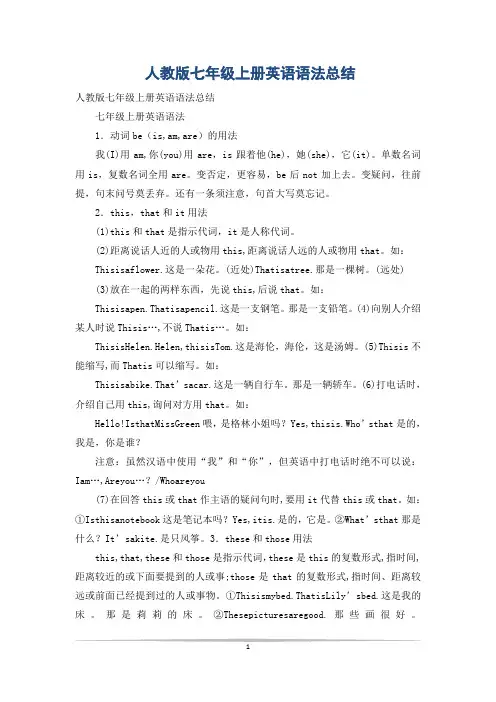
人教版七年级上册英语语法总结人教版七年级上册英语语法总结七年级上册英语语法1.动词be(is,am,are)的用法我(I)用am,你(you)用are,is跟着他(he),她(she),它(it)。
单数名词用is,复数名词全用are。
变否定,更容易,be后not加上去。
变疑问,往前提,句末问号莫丢弃。
还有一条须注意,句首大写莫忘记。
2.this,that和it用法(1)this和that是指示代词,it是人称代词。
(2)距离说话人近的人或物用this,距离说话人远的人或物用that。
如:Thisisaflower.这是一朵花。
(近处)Thatisatree.那是一棵树。
(远处)(3)放在一起的两样东西,先说this,后说that。
如:Thisisapen.Thatisapencil.这是一支钢笔。
那是一支铅笔。
(4)向别人介绍某人时说Thisis…,不说Thatis…。
如:ThisisHelen.Helen,thisisTom.这是海伦,海伦,这是汤姆。
(5)Thisis不能缩写,而Thatis可以缩写。
如:Thisisabike.That’sacar.这是一辆自行车。
那是一辆轿车。
(6)打电话时,介绍自己用this,询问对方用that。
如:Hello!IsthatMissGreen喂,是格林小姐吗?Yes,thisis.Who’sthat是的,我是,你是谁?注意:虽然汉语中使用“我”和“你”,但英语中打电话时绝不可以说:Iam…,Areyou…?/Whoareyou(7)在回答this或that作主语的疑问句时,要用it代替this或that。
如:①Isthisanotebook这是笔记本吗?Yes,itis.是的,它是。
②What’sthat那是什么?It’sakite.是只风筝。
3.these和those用法this,that,these和those是指示代词,these是this的复数形式,指时间,距离较近的或下面要提到的人或事;those是that的复数形式,指时间、距离较远或前面已经提到过的人或事物。
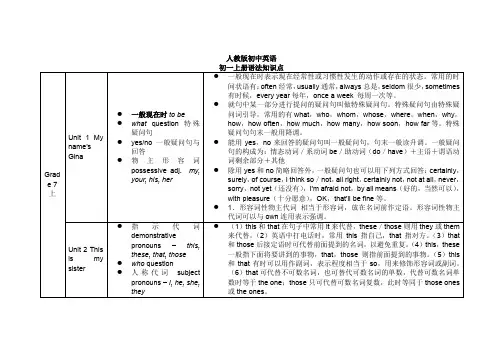
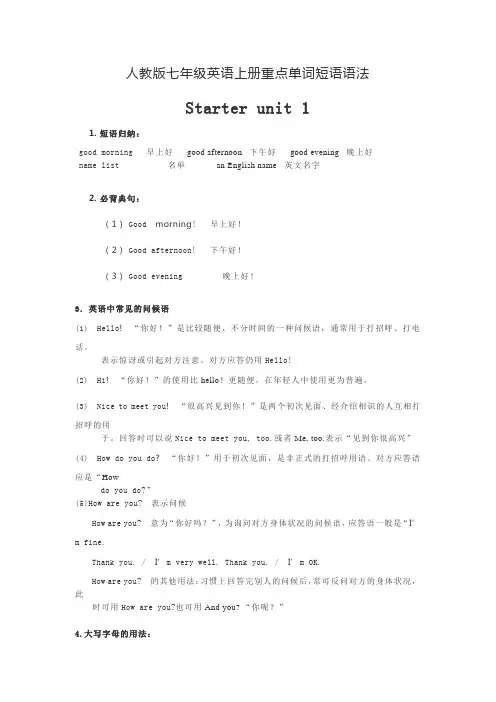
人教版七年级英语上册重点单词短语语法Starter unit 11. 短语归纳:good morning 早上好good afternoon 下午好good evening 晚上好name list 名单an English name 英文名字2. 必背典句:(1)Good morning! 早上好!(2)Good afternoon! 下午好!(3)Good evening 晚上好!3.英语中常见的问候语(1) Hello!“你好!”是比较随便、不分时间的一种问候语,通常用于打招呼、打电话。
表示惊讶或引起对方注意。
对方应答仍用Hello!(2) Hi!“你好!”的使用比hello!更随便,在年轻人中使用更为普遍。
(3) Nice to meet you!“很高兴见到你!”是两个初次见面、经介绍相识的人互相打招呼的用于。
回答时可以说Nice to meet you, too.或者Me, too.表示“见到你很高兴”(4) How do you do?“你好!”用于初次见面,是非正式的打招呼用语。
对方应答语应是“Howdo you do?”(5)How are you? 表示问候How are you? 意为“你好吗?”,为询问对方身体状况的问候语,应答语一般是“I’m fine.Thank you. / I’m very well. Thank you. / I’m OK.How are you? 的其他用法:习惯上回答完别人的问候后,常可反问对方的身体状况,此时可用How are you?也可用And you? “你呢?”4.大写字母的用法:(1) 在英语中,句子的第一个单词的第一个字母都应大写。
Sit down, please. 请坐。
(2)字母I作人称代词时,意为“我”,在句中任何位置都必须大写。
日常用语“OK”在句中任何位置都大写。
I’m a student. 我是一名学生。
Is everything OK? 一切都好吗?(3)人名、地名、国名、某国人或某种语言等专有名词的第一个字母都必须大写。
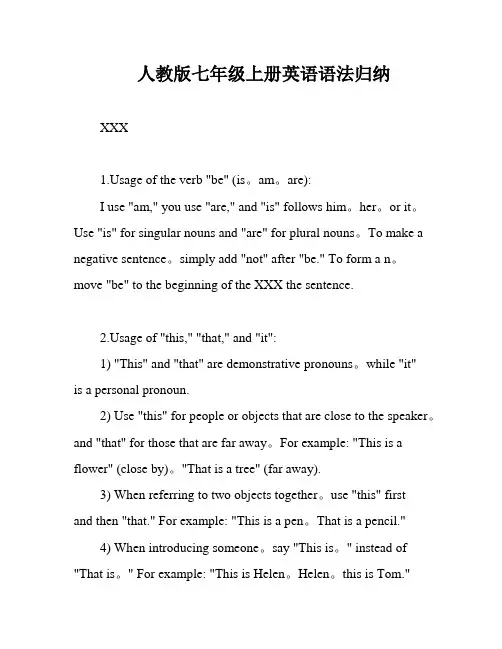
人教版七年级上册英语语法归纳XXXage of the verb "be" (is。
am。
are):I use "am," you use "are," and "is" follows him。
her。
or it。
Use "is" for singular nouns and "are" for plural nouns。
To make a negative sentence。
simply add "not" after "be." To form a n。
move "be" to the beginning of the XXX the sentence.age of "this," "that," and "it":1) "This" and "that" are demonstrative pronouns。
while "it"is a personal pronoun.2) Use "this" for people or objects that are close to the speaker。
and "that" for those that are far away。
For example: "This is a flower" (close by)。
"That is a tree" (far away).3) When referring to two objects together。
use "this" firstand then "that." For example: "This is a pen。
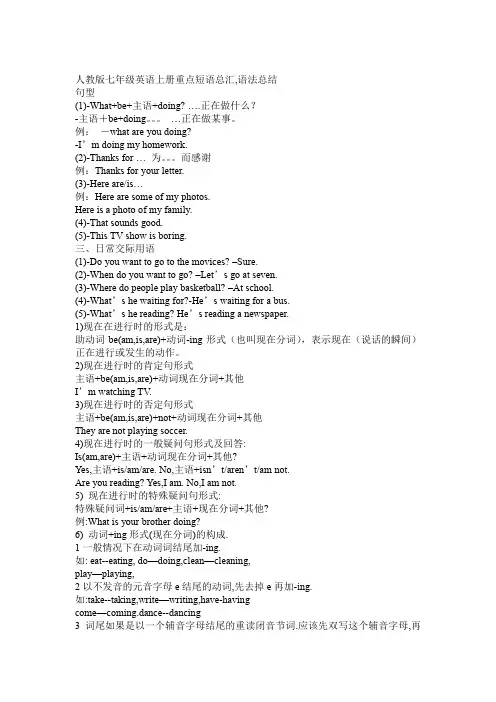
人教版七年级英语上册重点短语总汇,语法总结句型(1)-What+be+主语+doing? ….正在做什么?-主语+be+doing。
…正在做某事。
例:-what are you doing?-I’m doing my homework.(2)-Thanks for … 为。
而感谢例:Thanks for your letter.(3)-Here are/is…例:Here are some of my photos.Here is a photo of my family.(4)-That sounds good.(5)-This TV show is boring.三、日常交际用语(1)-Do you want to go to the movices? –Sure.(2)-When do you want to go? –Let’s go at seven.(3)-Where do people play basketball? –At school.(4)-What’s he waiting for?-He’s waiting for a bus.(5)-What’s he reading? He’s reading a newspaper.1)现在在进行时的形式是:助动词be(am,is,are)+动词-ing形式(也叫现在分词),表示现在(说话的瞬间)正在进行或发生的动作。
2)现在进行时的肯定句形式主语+be(am,is,are)+动词现在分词+其他I’m watching TV.3)现在进行时的否定句形式主语+be(am,is,are)+not+动词现在分词+其他They are not playing soccer.4)现在进行时的一般疑问句形式及回答:Is(am,are)+主语+动词现在分词+其他?Yes,主语+is/am/are. No,主语+isn’t/aren’t/am not.Are you reading? Yes,I am. No,I am not.5) 现在进行时的特殊疑问句形式:特殊疑问词+is/am/are+主语+现在分词+其他?例:What is your brother doing?6) 动词+ing形式(现在分词)的构成.1一般情况下在动词词结尾加-ing.如: eat--eating, do—doing,clean—cleaning,play—playing,2以不发音的元音字母e结尾的动词,先去掉e再加-ing.如:take--taking,write—writing,have-havingcome—coming.dance--dancing3词尾如果是以一个辅音字母结尾的重读闭音节词.应该先双写这个辅音字母,再加-ing.如:run—runing,sit—sitting ,swim—swimming.Shop—shopping.put—putting,sit—sittingUnit 6 It’s raning!一、词组Around The World 世界各地On vacation 度假Take photos 拍照On the beach 在海边a group of people 一群人play beach volleyball 打沙滩排球be surprised 惊讶的be surprised at sth./sb.对某人或某人感到惊讶be relaxed 放松have a good time 玩得很痛快in different kind of weather 在不同的天气里Thank sb for(doing)sth由于(做)某事而感谢某人How’s it going? 近况如何Some…others…一些…另一些…Look like..看起来像。
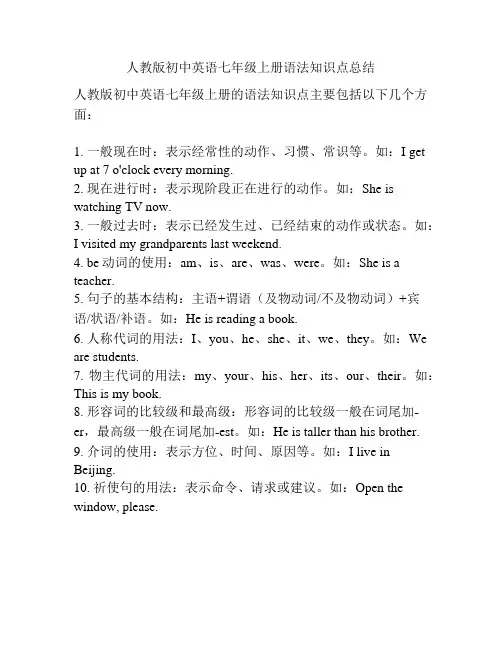
人教版初中英语七年级上册语法知识点总结
人教版初中英语七年级上册的语法知识点主要包括以下几个方面:
1. 一般现在时:表示经常性的动作、习惯、常识等。
如:I get up at 7 o'clock every morning.
2. 现在进行时:表示现阶段正在进行的动作。
如:She is watching TV now.
3. 一般过去时:表示已经发生过、已经结束的动作或状态。
如:
I visited my grandparents last weekend.
4. be动词的使用:am、is、are、was、were。
如:She is a teacher.
5. 句子的基本结构:主语+谓语(及物动词/不及物动词)+宾
语/状语/补语。
如:He is reading a book.
6. 人称代词的用法:I、you、he、she、it、we、they。
如:We are students.
7. 物主代词的用法:my、your、his、her、its、our、their。
如:This is my book.
8. 形容词的比较级和最高级:形容词的比较级一般在词尾加-er,最高级一般在词尾加-est。
如:He is taller than his brother. 9. 介词的使用:表示方位、时间、原因等。
如:I live in Beijing.
10. 祈使句的用法:表示命令、请求或建议。
如:Open the window, please.。
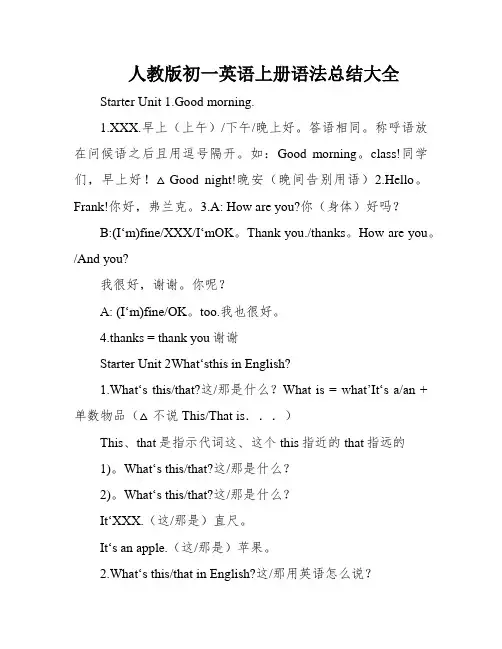
人教版初一英语上册语法总结大全Starter Unit 1.Good morning.1.XXX.早上(上午)/下午/晚上好。
答语相同。
称呼语放在问候语之后且用逗号隔开。
如:Good morning。
class!同学们,早上好!△Good night!晚安(晚间告别用语)2.Hello。
Frank!你好,弗兰克。
3.A: How are you?你(身体)好吗?B:(I‘m)fine/XXX/I‘mOK。
Thank you./thanks。
How are you。
/And you?我很好,谢谢。
你呢?A: (I‘m)fine/OK。
too.我也很好。
4.thanks = thank you谢谢Starter Unit 2What‘sthis in English?1.What‘s this/that?这/那是什么?What is = what’It‘s a/an +单数物品(△不说This/That is...)This、that是指示代词这、这个this指近的that指远的1)。
What‘s this/that?这/那是什么?2)。
What‘s this/that?这/那是什么?It‘XXX.(这/那是)直尺。
It‘s an apple.(这/那是)苹果。
2.What‘s this/that in English?这/那用英语怎么说?It‘s a/an +单数物品(△不说This/That is...)What‘s this in English?这用英语怎么说?It’s a jacket.夹克衫What‘s that in English?那用英语怎么说?It’s an orange.橘子。
in +语言:用某种语言in为介词XXX用汉/英/日语3.a和an是不定冠词,只用在可数名词单数前面,表示―一‖。
a用在以辅音音素开头的单词前;an用在以元音音素开头的单词前。
这里的元音音素和辅音音素是指读音,而不是指字母。
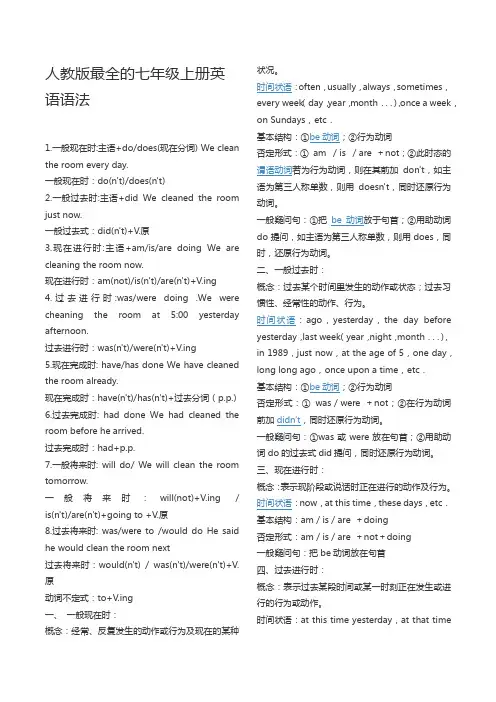
人教版最全的七年级上册英语语法1.一般现在时:主语+do/does(现在分词) We clean the room every day.一般现在时:do(n't)/does(n't)2.一般过去时:主语+did We cleaned the room just now.一般过去式:did(n't)+V.原3.现在进行时:主语+am/is/are doing We are cleaning the room now.现在进行时:am(not)/is(n't)/are(n't)+V.ing4.过去进行时:was/were doing .We were cheaning the room at 5:00 yesterday afternoon.过去进行时:was(n't)/were(n't)+V.ing5.现在完成时: have/has done We have cleaned the room already.现在完成时:have(n't)/has(n't)+过去分词(p.p.)6.过去完成时: had done We had cleaned the room before he arrived.过去完成时:had+p.p.7.一般将来时: will do/ We will clean the room tomorrow.一般将来时:will(not)+V.ing / is(n't)/are(n't)+going to +V.原8.过去将来时: was/were to /would do He said he would clean the room next过去将来时:would(n't) / was(n't)/were(n't)+V.原动词不定式:to+V.ing一、一般现在时:概念:经常、反复发生的动作或行为及现在的某种状况。
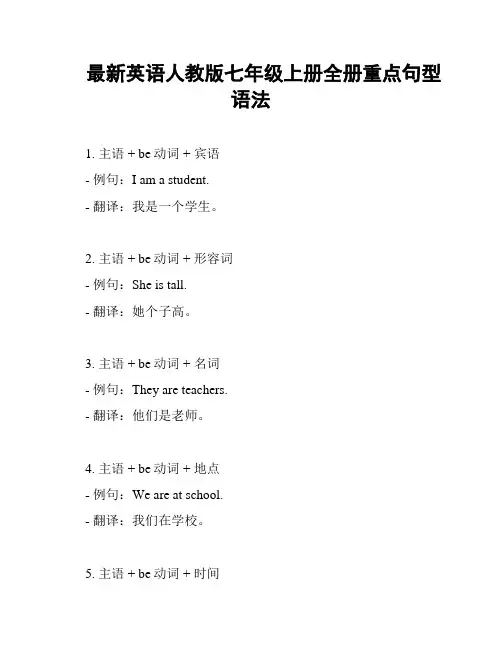
最新英语人教版七年级上册全册重点句型语法1. 主语 + be动词 + 宾语- 例句:I am a student.- 翻译:我是一个学生。
2. 主语 + be动词 + 形容词- 例句:She is tall.- 翻译:她个子高。
3. 主语 + be动词 + 名词- 例句:They are teachers.- 翻译:他们是老师。
4. 主语 + be动词 + 地点- 例句:We are at school.- 翻译:我们在学校。
5. 主语 + be动词 + 时间- 例句:He is in the classroom at 8 o'clock. - 翻译:他在八点钟在教室里。
6. 主语 + be动词 + 副词- 例句:I am here.- 翻译:我在这里。
7. 主语 + have + 名词- 例句:We have a book.- 翻译:我们有一本书。
8. 主语 + have + 动词过去分词- 例句:He has finished his homework.- 翻译:他已经完成了他的作业。
9. 主语 + have + to + 动词原形- 例句:They have to study for the test.- 翻译:他们必须为考试研究。
10. 主语 + can + 动词原形- 例句:She can swim.- 翻译:她会游泳。
11. 主语 + can + 动词原形 + 物品- 例句:We can ride bicycles.- 翻译:我们会骑自行车。
12. 主语 + can't + 动词原形- 例句:He can't speak Chinese.- 翻译:他不会说中文。
13. 主语 + like + 名词/动词/动词-ing- 例句:They like basketball.- 翻译:他们喜欢篮球。
14. 主语 + don't/doesn't + like + 名词/动词/动词-ing - 例句:She doesn't like swimming.- 翻译:她不喜欢游泳。
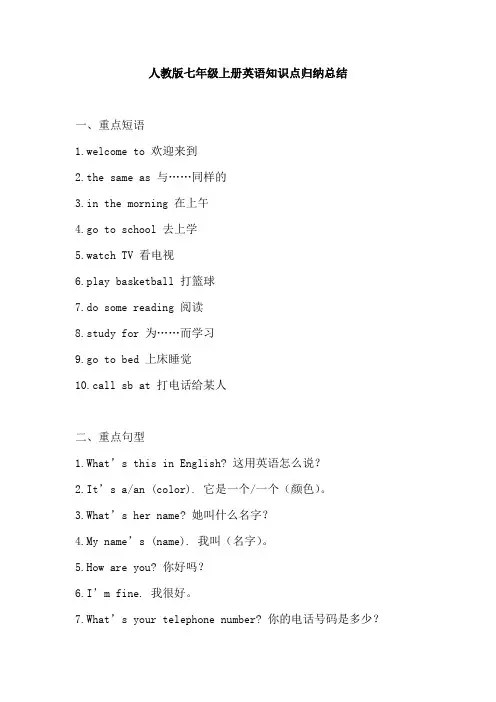
人教版七年级上册英语知识点归纳总结
一、重点短语
1.welcome to 欢迎来到
2.the same as 与……同样的
3.in the morning 在上午
4.go to school 去上学
5.watch TV 看电视
6.play basketball 打篮球
7.do some reading 阅读
8.study for 为……而学习
9.go to bed 上床睡觉
10.call sb at 打电话给某人
二、重点句型
1.What’s this in English? 这用英语怎么说?
2.It’s a/an (color). 它是一个/一个(颜色)。
3.What’s her name? 她叫什么名字?
4.My name’s (name). 我叫(名字)。
5.How are you? 你好吗?
6.I’m fine. 我很好。
7.What’s your telephone number? 你的电话号码是多少?
8.Can you help me? 你能帮助我吗?
9.What time is it? 现在几点了?
10.It’s time to do sth. 是做某事的时间了。
三、重点语法
1.名词的复数形式。
2.动词的第三人称单数形式。
3.名词的格。
4.疑问句和否定句的构成和回答。
5.时间表达法。

人教版七年级英语上册重点单词短语语法Starter unit 11. 短语归纳:good morning 早上好good afternoon 下午好good evening 晚上好name list 名单an English name 英文名字2. 必背典句:(1)Good morning! 早上好!(2)Good afternoon! 下午好!(3)Good evening 晚上好!3.英语中常见的问候语(1) Hello!“你好!”是比较随便、不分时间的一种问候语,通常用于打招呼、打电话。
表示惊讶或引起对方注意。
对方应答仍用Hello!(2) Hi!“你好!”的使用比hello!更随便,在年轻人中使用更为普遍。
(3) Nice to meet you!“很高兴见到你!”是两个初次见面、经介绍相识的人互相打招呼的用于。
回答时可以说Nice to meet you, too.或者Me, too.表示“见到你很高兴”(4) How do you do?“你好!”用于初次见面,是非正式的打招呼用语。
对方应答语应是“Howdo you do?”(5)How are you? 表示问候How are you? 意为“你好吗?”,为询问对方身体状况的问候语,应答语一般是“I’m fine.Thank you. / I’m very well. Thank you. / I’m OK.How are you? 的其他用法:习惯上回答完别人的问候后,常可反问对方的身体状况,此时可用How are you?也可用And you? “你呢?”4.大写字母的用法:(1) 在英语中,句子的第一个单词的第一个字母都应大写。
Sit down, please. 请坐。
(2)字母I作人称代词时,意为“我”,在句中任何位置都必须大写。
日常用语“OK”在句中任何位置都大写。
I’m a student. 我是一名学生。
Is everything OK? 一切都好吗?(3)人名、地名、国名、某国人或某种语言等专有名词的第一个字母都必须大写。
人教版七年级上册英语语法
人教版七年级上册英语语法主要涵盖了一些基础的语法知识和句型结构。
以下是七年级上册英语语法的主要内容:
1. (现在简单时):用于表达经常性的动作、习惯或客观事实。
例如:I play football every day.
2. (现在进行时):用于表示正在进行的动作。
例如:She is reading a book now.
3. (过去简单时):用于表示过去某个时间发生的动作或状态。
例如:He visited his grandparents last weekend.
4. (将来简单时):用于表示将来会发生的动作或事件。
例如:I will call you tomorrow.
5. (比较级和最高级):用于比较两者或多者之间的程度或大小。
例如:She is taller than her sister.
6. (介词):用于表示位置、方向、时间等。
例如:The book is on the table.
7. 冠词):包括定冠词“the”和不定冠词“a/an”,用于限定名词。
例如:A cat is on the roof.
8. (情态动词):如can, could, may, might, must, shall, should, will, would 等,用于表示情态、推测、建议等。
例如:You must finish your homework.
以上是七年级上册英语语法的一些主要内容,学生在学习过程中需要掌握这些基础知识,并能够正确运用到实际语境中。
人教版七年级上册英语语法整理一. 词汇⑴单词1. 介词:in, on, under, behind, near, at, of1). in表示"在……中", "在……内"。
例如:our class 在我们班上 in my bag 在我的书包里in the desk 在桌子里 in the classroom 在教室里2). on 表示"在……上"。
例如:on the wall 在墙上 on the desk 在桌子上 on the blackboard 在黑板上3). under表示"在……下"。
例如:under the tree 在树下 under the chair 在椅子下under the bed 在床下4). behind表示"在……后面"。
例如:behind the door 在门后 the tree 在树后5). near表示"在……附近"。
例如:near the teacher's desk 在讲桌附近 near the bed 在床附近6). at表示"在……处"。
例如:at school 在学校 at home 在家 at the door 在门口7). of 表示"……的"。
例如:a picture of our classroom 我们教室的一幅画 map of China 一张中国地图2. 冠词 a / an / the:冠词一般位于所限定的名词前,用来署名名词所指的人或事物。
冠词有不定冠词和定冠词两种。
不定冠词有两个形式,即a和an。
a用在以辅音音素开头的词前,如a book; an用在以元音音素开头的字母前,如an apple.a或an与可数名词单数连用,泛指某类人或某物中的一个。
This is a cat.这是一只猫。
目录第一讲:动词1.Be 动词2.动词第三人称单数第二讲:代词1.人称代词及物主代词2.指示代词第三讲:名词1.名词的数2.名词的所有格第四讲:数词1.基数词2.序数词第五讲:介词第六讲:句型1.肯定句2.否定句3.一般疑问句4.特殊疑问句5.There be 句型第一讲:动词(一)Be 动词(am, is, are)的用法口诀:I 用am , you 用are ,is 连着他(he)她(she)它(it)。
单数统统用is,复数一律都用are. 变疑问,往前提,句末问号莫丢弃,变否定,更容易,be 后not莫忘记,疑问否定任你变,句首大写莫迟疑。
注意:be 动词通常会和其他词连写在一起,如:I’m , what’s ,name’s, they’re等For example:-What is your name?= -What’s your name?-My name is Cindy. = -My name’s Cindy.-Are you a student? = -Are you a student?-Yes, I am a student. = –Yes, I’m a student.-What are they? =-What are they?-They are apples. =They’re apples.What is this? =What’s this?ExercisesI ________ a student. You ________ Japanese.He _______ my brother. She_______ very nice.My name ________Harry. I _______ 10 years old.LiLei _________ very tall. Mary, this _________ Tom.What_____ this? Miss Zhou ________ my teacher.This book________ very interesting. Li Lei and I __________ good friends.These ________ apples. Those_________ bananas.They _________students. There _______ some bread on the plate.The cat________ black. ________ she from China?________ you good at English? The books ________ on the desk.The black pants ______ for Su Yang. This ______ not Wang Fang's pencil.Here ______ some sweaters for you. There ______ a girl in the room.This pair of boots ______ for Yang Ling. ______ David and Helen from England?There some milk for me. There ______ some apples on the tree._______ there any kites in the classroom? Gao Shan's shirt _______ over there.Some tea ______ in the glass. My sister's name ______Nancy._______ there any apple juice in the bottle? My telephone number ________ 8563-0770.(二)动词第三人称单数的构成规则:a.一般情况下在动词词尾加s 如:get----gets like----likes play—plays,want—wants,work—works,know—knows,help—helps,get—getsb. 以字母s、x、ch或o结尾的动词加-es;如:guess—guesses,fix—fixes,teach—teaches,brush—brushes,go—goes,do—does,watch—watches,catch—catchesc. 以辅音字母+y结尾的动词,先变y为i,再加-es。
七年级上册语法总结一、词类二、名词1.名词:表示人或事物的名称1)总的来说,名词分为专有名词和普通名词两类。
专有名词时个别的人、事物、地点等专有的名称,如:Gina, China 等专有名词,专有名词第一个字母要大写。
2)名词按其所表示事物的性质分为可数名词和不可数名词。
可数名词(Countable Nouns)有复数形式,如:an apple, two apples。
不可数名词(Uncountable Nouns)一般没有复数形式,如:broccoli。
3)可数名词有单数(Singular Form)和复数(Plural Form)两种形式,以下介绍可数名词复数形式变化规则:*本册出现的不可数名词有:broccoli*既可数又不可数名词有:ice cream,salad,chicken2.名词所有格表示所属关系的一种格式1)-’s 所有格大多数表示有生命的名词的所有格名词,加-’s表示为各自所有的各个名词后都要变化,分别加-’sTom’s and Lucy’s books2)无生命的名词的所有格,一般由“名词+of+名词”构成Eg:a map of China 一副中国地图the capital of America 美国的首都*双重所有格由“名词+of+-’s”或“名词+of+名词性物主代词”构成Eg:a friend of my mother’s一个我妈妈的朋友a friend of theirs/his/hers/ours三、代词1.含义:代词是代替名词以及起名词作用的短语、不定式、V-ing 形式、从句或整个句子的词。
2.代词的分类(本书涉及三类代词):1).指示代词表示“这个”、“那个”、“这些”、“那些”等指示概念的代词单数复数用法例句this these 一般用来指时间或空间上较近的事物Is this your pencil?These are my pens.that those 一般用来指时间后空间上较远的事物Is that you grandfather?Those are his brothers.2)人称代词代指人或事物,在句中作主语或宾语,所以有主格和宾格形式人称单数复数主格宾格主格宾格第一人称I me we us第二人称you you you you第三人称he himthey themshe herit it3)物主代词表示所有关系的单词,是人称代词的属格形式。
人教版初中英语七年级上册语法知识点总结一、词类【练习】:判断以下单词的词性:finish ___________ lesson __________ Sunday __________ cool__________ long________ take __________ twenty ___________ sell __________ healthy _______ clothes _______ second__________ some_________eat__________ well __________ really_________ question_________ shorts_________ short__________ lunch__________ favorite_________ history_________ student_________ busy__________ art___________on__________ but___________ our___________ always________know_________ play___________ interesting_________ difficult_________watch_________ right____________ then__________ under___________think ___________ parent___________ me __________ those___________of__________ his_________ at__________ am________it_________ what ________ when_________She’s my sister. That sounds interesting. Let’s play computer games!____________ ____________________ _____________________My favorite subject is Math. I don’t like geography because it’s boring.________________________ ____________________________________He has two science classes on Tuesday. Volleyball is so difficult.______________________________ __________________________My name is Alice._______________二、名词名词指人或事物的名称1总的来说,名词分为专有名词和普通名词两大类。
七年级上册英语语法1.介词:in, on, under, behind, near, at, of1). in表示"在……中", "在……内"。
例如: in our class 在我们班上 in my bag 在我的书包里 in the desk 在桌子里 in the classroom 在教室里2). on blackboard 在黑板上3). under表示"在……下"。
例如: under the tree 在树下 under the chair 在椅子下 under the bed 在床上4). behind表示"在……后面"。
例如: behind the door 在门后 behind the tree 在树后5). near表示"在……附近"。
例如: near the teacher's desk 在讲桌附近 near the bed 在床附近6). at表示"在……处"。
例如: at school 在学校 at home 在家 at the door 在门口7). of 表示"……的"。
例如: a picture of our classroom 我们教室的一幅画 a map of China 一张中国地图2.冠词 a / an / the: 冠词一般位于所限定的名词前,用来署名名词所指的人或事物。
冠词有不定冠词和定冠词两种。
1)不定冠词有两个形式,即a和an。
a用在以辅音音素开头的词前,如a book; an用在以元音音素开头的字母前,如an apple. a或an与可数名词单数连用,泛指某类人或某物中的一个。
This is a cat. 这是一只猫。
It's an English book. 这是一本英语书。
His father is a worker. 他的爸爸是个工人。
人教版七年级英语上册语法总结一.动词be(is,am,are)的用法我(I)用am, 你(you)用are,is跟着他(he),她(she),它(it)。
单数名词用is,复数名词全用are。
变否定,更容易,be 后not加上去。
变疑问,往前提,句末问号莫丢弃。
还有一条须注意,句首大写莫忘记。
二.this,that和it用法(1)this和that是指示代词,it是人称代词。
@(2)距离说话人近的人或物用this, 距离说话人远的人或物用that。
如:This is a flower. 这是一朵花。
(近处)That is a tree. 那是一棵树。
(远处)(3)放在一起的两样东西,先说this, 后说that。
如:This is a pen. That is a pencil. 这是一支钢笔。
那是一支铅笔。
(4)向别人介绍某人时说This is…, 不说That is…。
如:This is Helen. Helen, this is Tom. 这是海伦,海伦,这是汤姆。
(5)This is 不能缩写, 而That is可以缩写。
如:—This is a bike. Th at’s a car. 这是一辆自行车。
那是一辆轿车。
(6)打电话时,介绍自己用this, 询问对方用that。
如:—Hello! Is that Miss Green 喂,是格林小姐吗—Yes, this is. Who’s that 是的,我是,你是谁注意:虽然汉语中使用“我”和“你”,但英语中打电话时绝不可以说:I am…, Are you…/Who are you(7)在回答this或that作主语的疑问句时, 要用it代替this或that。
如:①—Is this a notebook 这是笔记本吗—Yes, it is. 是的,它是。
.②—What’s that 那是什么—It’s a kite. 是只风筝。
三.these和those用法this, that, these和those是指示代词,these是this的复数形式,指时间,距离较近的或下面要提到的人或事;those是that的复数形式,指时间、距离较远或前面已经提到过的人或事物。
①This is my bed. That is Lily’s bed. 这是我的床。
那是莉莉的床。
②These pictures are good. 那些画很好。
③ Are those apple trees 那些是苹果树吗在回答主语是these或those的疑问句时,通常用they代替these或those以避免重复。
如:…④Are these/those your apples 这些(那些)是你的苹果吗Yes, they are. 是的,他们是。
四.不定冠词a和ana和an都是不定冠词,表示一(个,支,本,块……)的意思,但不强调数量概念,而是强调类别,用来限定名词。
a用在辅音素开头的单数名词前,如:a pencil(一支铅笔),a book(一本书);an用在元音音素开头的名词前,如an eraser(一块橡皮)。
如果名词前有修饰语,用a还是用an,则以该修饰语的第一音素决定用a还是用an。
如: a clock 一座钟an old clock 一座旧钟a book 一本书an English book 一本英语书a nice apple 一个可爱的苹 an apple 一个苹果;五.名词+’s所有格名词+’s所有格1.单数名词后直接加“ ’s ”Jim’s coat 吉姆的外套Jeff’s mother杰夫的妈妈2.以s结尾的复数名词,只加“’”Teachers’ Day教师节the twins’ books双胞胎的书3.不以s结尾的不规则的名词复数,加“ ’s ”Children’s Day 儿童节men’s shoes男式鞋"4.表示两者共同拥有时,只在最后一个名词后加’s5.表示两者各自拥有时,要在每个名词后加’sLucy and Lily’s mother 露茜和莉莉的妈妈(共同的妈妈,一个妈妈)Lucy’s and Kate’s rooms 露茜和凯特的房间(各自的房间,两间房子)六.There be句型(1)There be句型主要用以表达“某处(某时)有某人(某物)。
”其基本结构为“There be+某物(某人)+某地(某时)”其中there 是引导词,没有词义;主语是be后面的名词, be是谓语动词,在一般现在时中be只用is和are两种形式。
下面这首歌诀可帮你巧记there be句型结构:There be放句首,主语跟在后。
地、时放句末,强调置前头。
如:There is a book on the desk.、有时为了强调地点,也可把介词短语放在句首。
如:On the desk there is a book.(2)There be句型中的be动词如何确定呢请先看看下面这首歌诀:Be动词,有三个,am,is还有are。
“There be”真特别,不留am只留俩,那就是is还有are。
要用is还是are,须看其后的名词是单数还是复数。
若是单数或不可数名词用is,否则就用are。
如:①There is a tree behind the house.②There is some water(水)in the bottle(瓶子).③There are some pears in the box.(3)注意:如果“be”后的主语是由and连接的两个或两个以上的名词,那么be的形式要遵循“远亲不如近邻”的原则。
也就是说,“be”的形式是由与它最近的那个名词来确定的。
若那个名词是单数或不可数名词要用is,是复数就用are。
如:、①There is a book and some pens on the floor.②There are some pens and a book on the floor.七.like一词的用法like用作及物动词,译为“喜欢”。
(1)后接名词或代词,表示喜欢某人或某物。
如:I like the baby very much. 我非常喜欢这个小孩。
(2)后接动名词(v. -ing),表示“喜欢做某事”,着重于习惯、爱好。
如::Tom likes playing football. 汤姆喜欢踢足球。
(3)后接动词不定式(to do ),表示“偶尔地喜欢做某事”,着重于某次具体的行为。
如:I like reading, but I like to watch TV this evening. 我喜欢读书,但我今晚想看电视。
八.一般现在时一般现在时表示经常性、习惯性的动作,或表示现在的特征、状态。
当主语是非第三人称单数时,行为动词的一般现在时变化形式(见下表)。
如:句式结构例句肯定句主语+行为动词原形+其他 We speak Chinese.否定句主语+don’t+行为动词原形+其他We don’t speak Chinese.|一般疑问句 Do+主语+行为动词原形+其他 Do you speak Chinese肯定回答否定回答 Yes,主语+doNo,主语+don’t Yes, we do.No, we don’t.当主语是第三人称单数时,行为动词一般现在时的句型变化如下:(1)肯定句在行为动词原形后+s/es(其构成方法与名词单数变复数相同)。
(2)否定句用助动词doesn’t+动词原形。
》(3)一般疑问句则是把助动词does放在句首,后面动词用原形,回答时,肯定用“Yes,主语+does.”;否定用“No,主语+doesn’t.”。
句式结构例句肯定句主语+行为动词s/es+其他 She speaks Chinese.否定句主语+doesn’t+行为动词原形+其他She doesn’t speak Chinese.一般疑问句 Does+主语+行为动词原形+其他 Does she speak Chinese肯定回答否定回答 Yes,主语+doesNo,主语+doesn’t Yes, she does.—No, she doesn’t.九.句子单数变复数,注意以下五要素(1)主格人称代词要变成相应的复数主格人称代词,即I→we, you→you,she,he,it→ they。
如:She is a girl. →They are girls.(2)am,is要变为are。
如:I’m a student. →We are students.(3)不定冠词a,an要去掉。
如:He is a boy. →They are boys.—(4)普通单数名词要变为复数形式。
如:It is an apple. →They are apples.(5)指示代词this,that要变为these,those。
如:This is a box. →These are boxes.十.英语日期的表示法英语中月份和星期名称都是专有名词,它们的首字母必须大写,并且前面无需用冠词。
用英语表示日期,其顺序为月+日+年,日和年之间需用逗号隔开。
如:August 2nd,2003(2003年8月2日)。
也可以用日+月+年来表示。
如:10th May,2003(2003年5月10日)英语日期前介词的使用:若指在哪一年或哪一月,则用介词in,若具体到某一天,则需用介词on。
①She was born in 1989—②She was born in August.③She was born in August 1989.④She was born on 2nd August, 1989.十一.名词复数:在英语里面,名词分可数名词(countable noun)和不可数名词(uncountable noun),不可数名词没有单复数之分,用时只当单数词用;可数名词有单复数之分,一个的前面要用a或an,eg: a pencil, a basketball, a dictionary, an egg, an ID card,而复数即两个或两个以上的要作相应的变化,情况如下:(1) 特殊词,特殊变化,需单独记:child→children,man→men,foot→feet,woman→women"tooth→teeth,sheep→sheep,deer→deer(2)一般的词在单数词后直接+“s”:book→books,pen→pens,car→cars,map→maps,cartoon→cartoons(3)以s,x,sh,ch结尾的词+“es”box→boxes,watch→watches(4)以辅音字母+y结尾的名词去掉“y”,改成“i”,再加“es”family→families,comedy→comedies(5)以f或fe结尾的词,先去掉f或fe,改成“v”再加es。